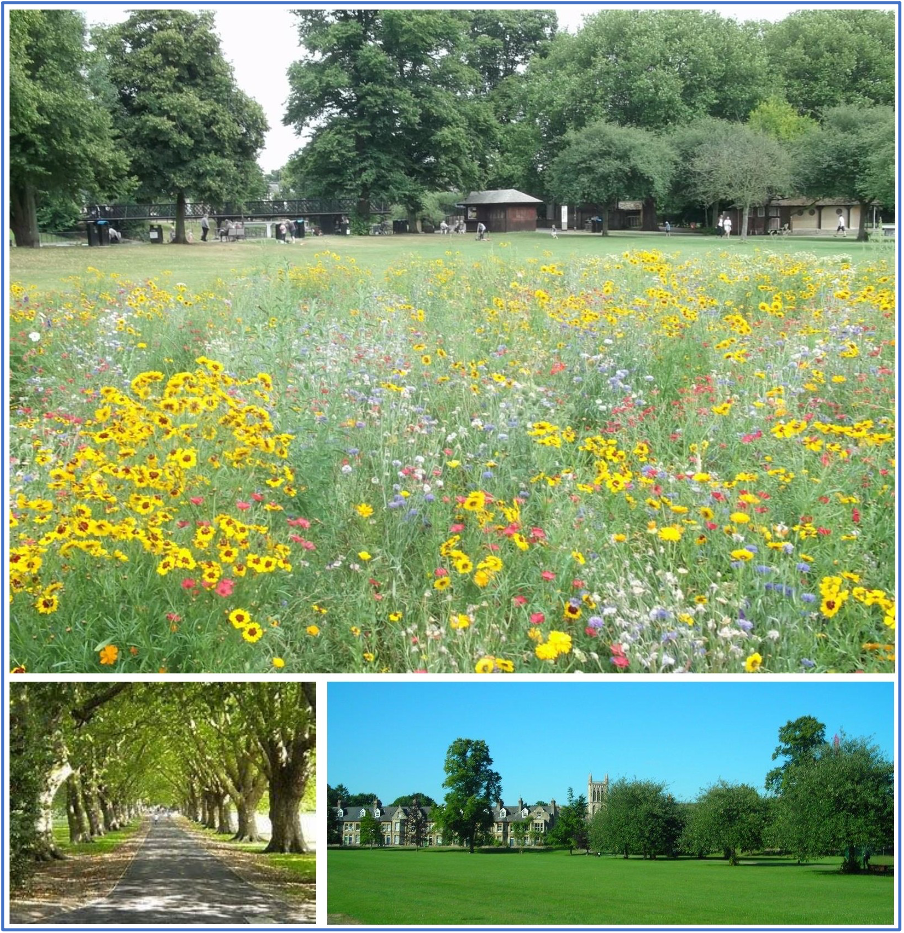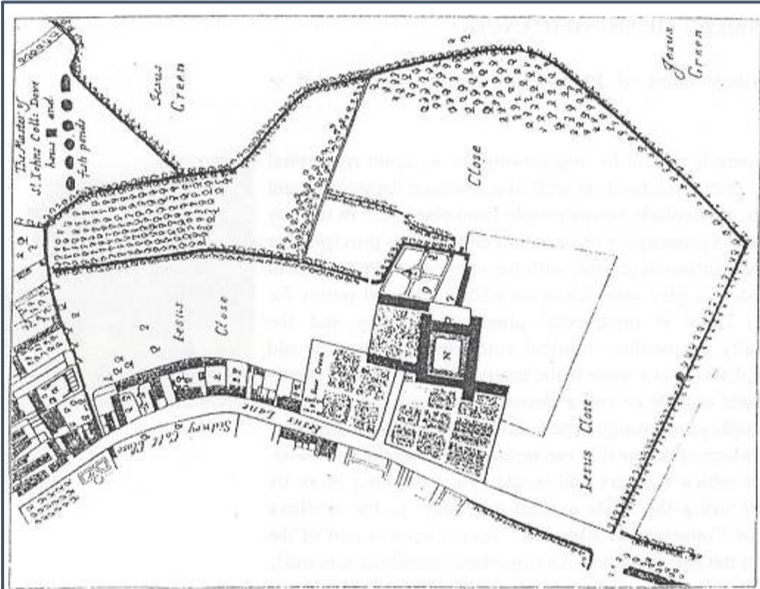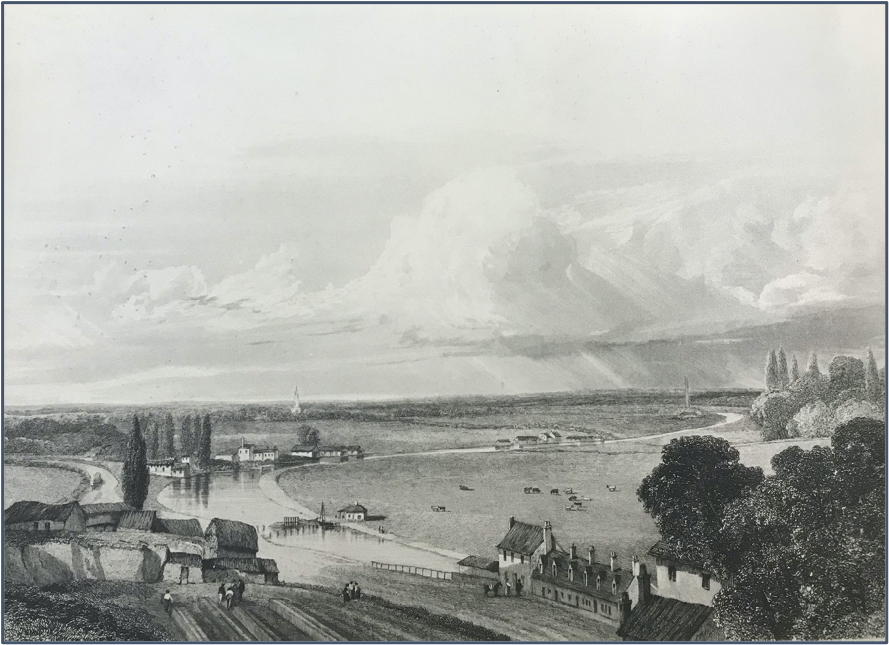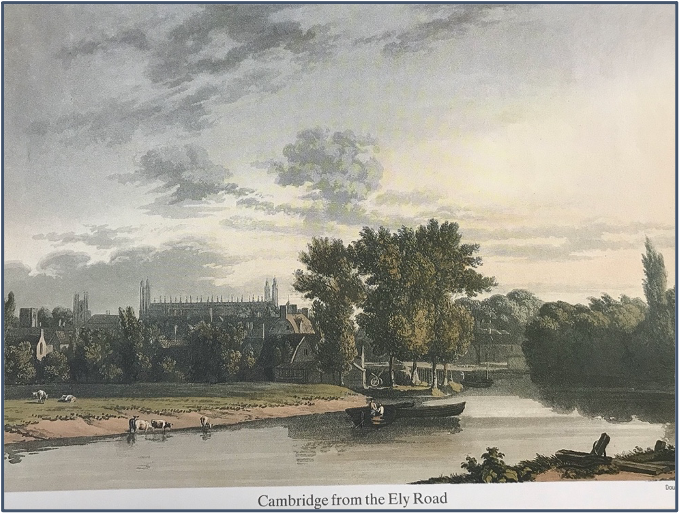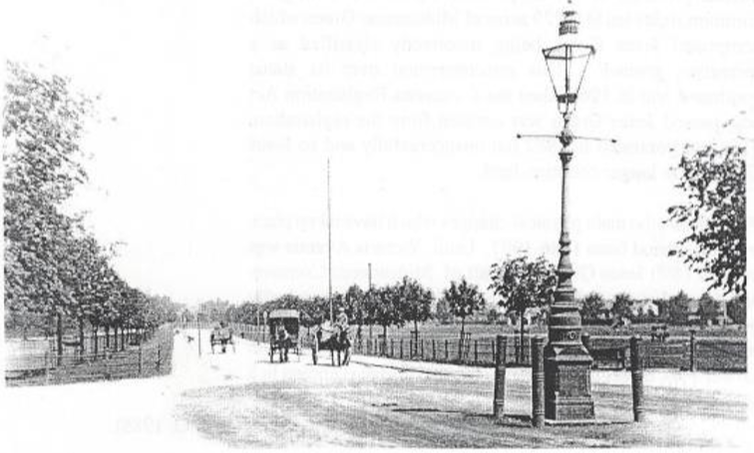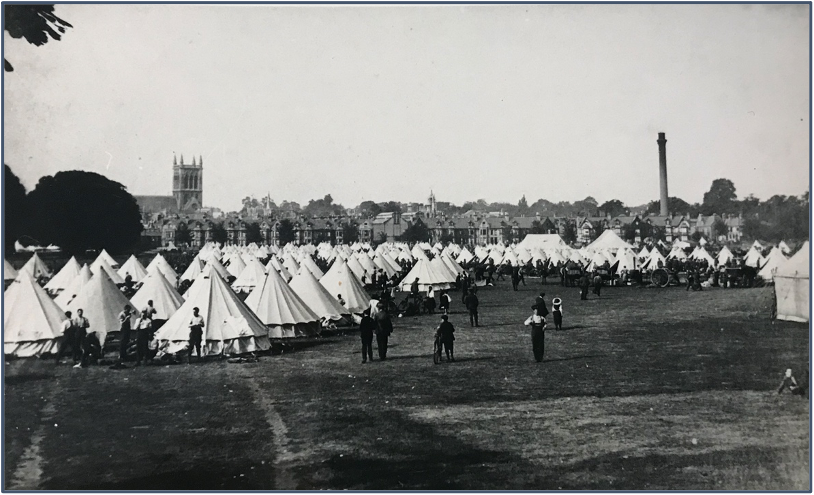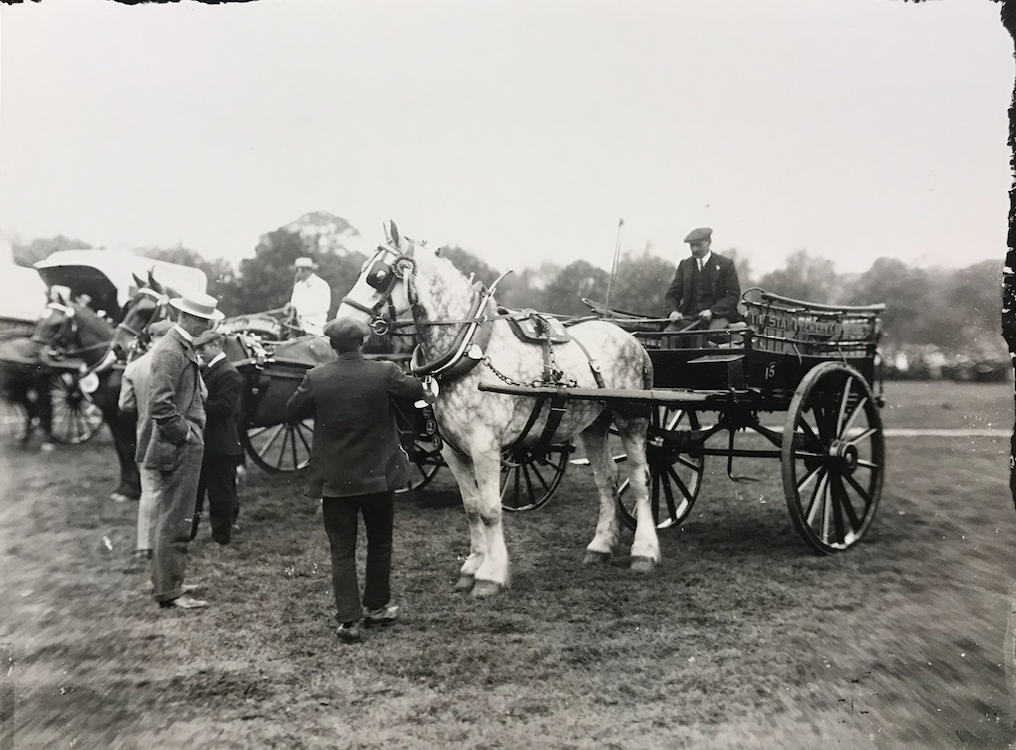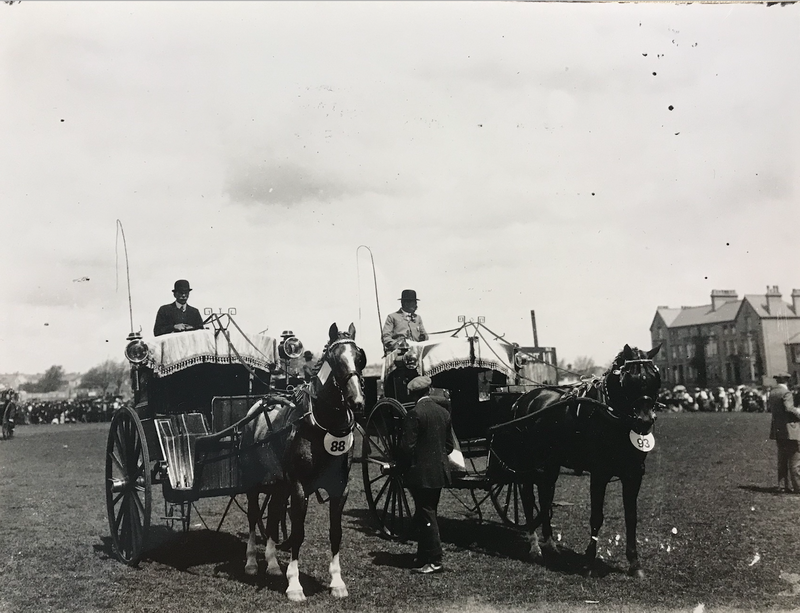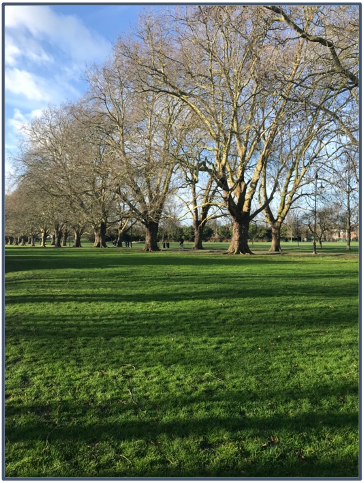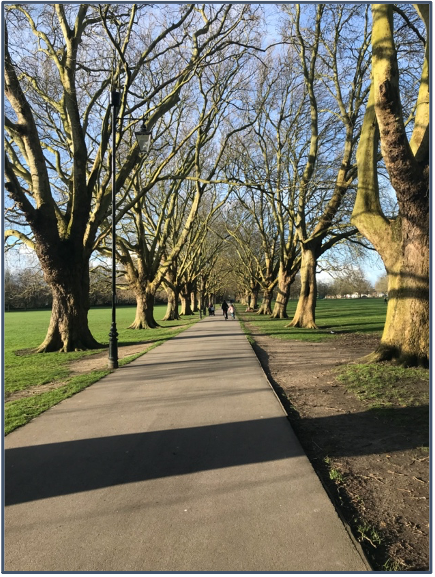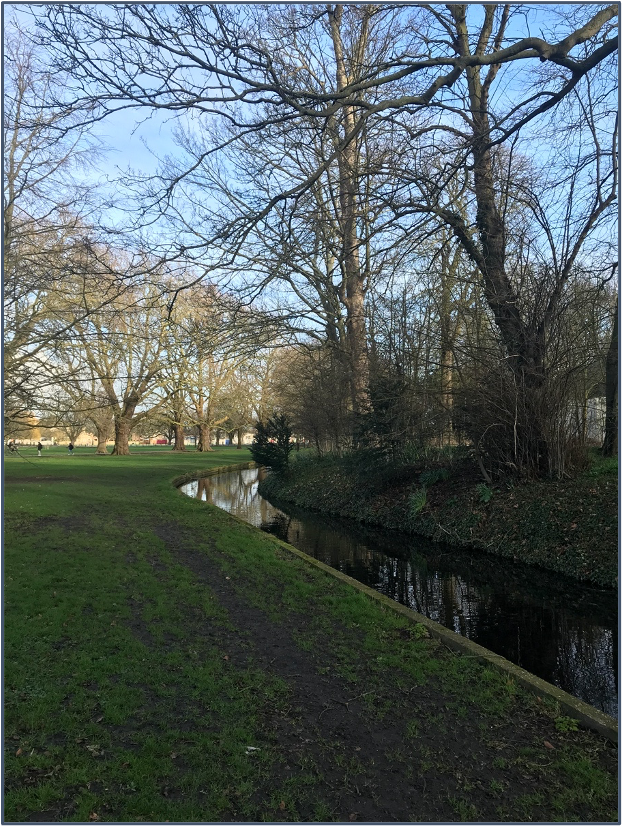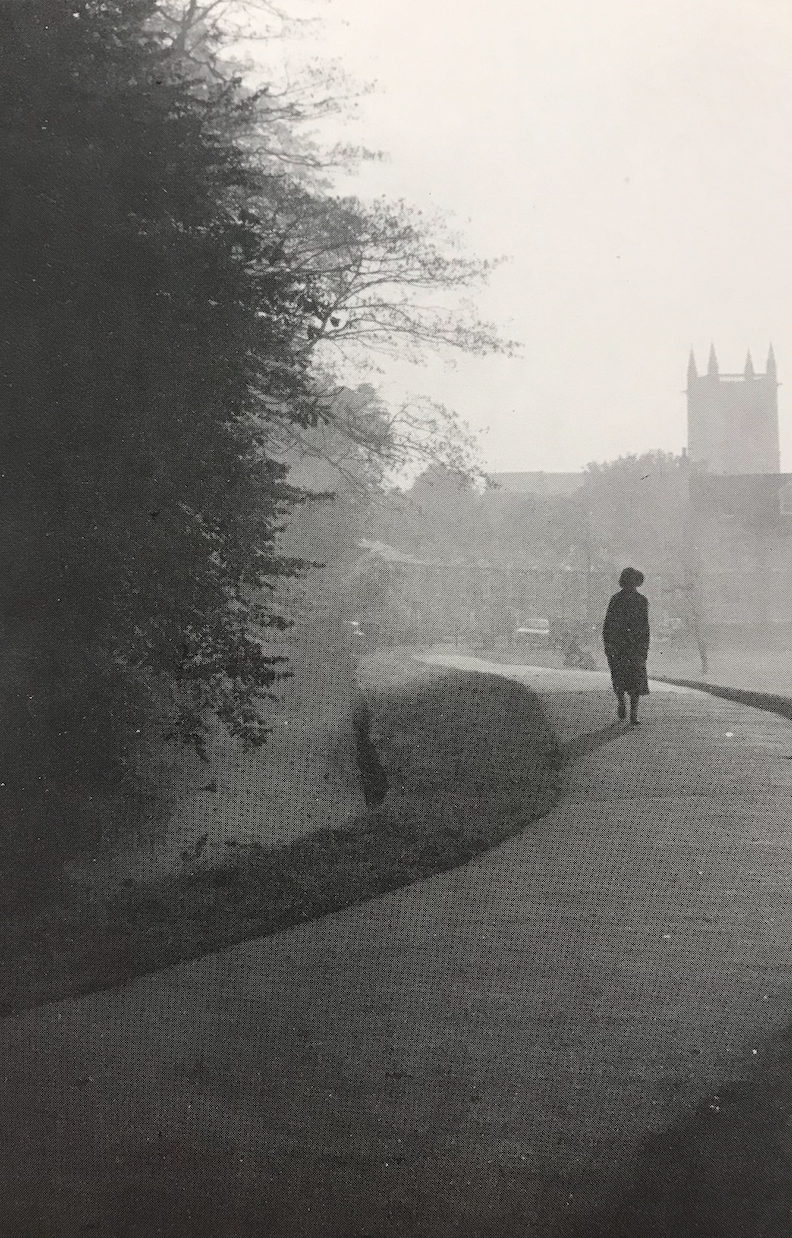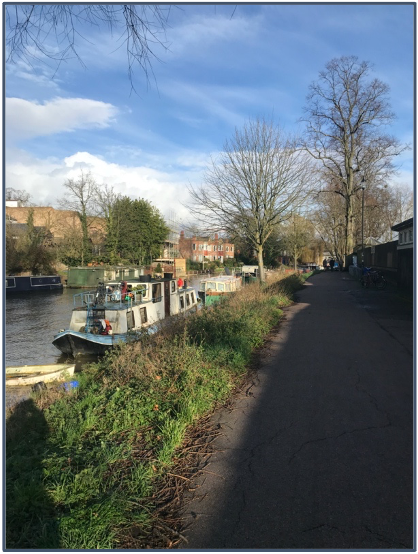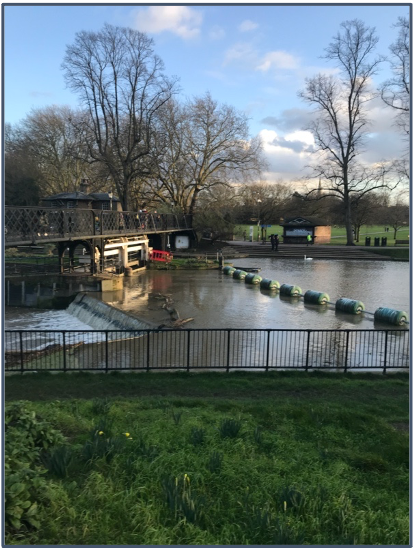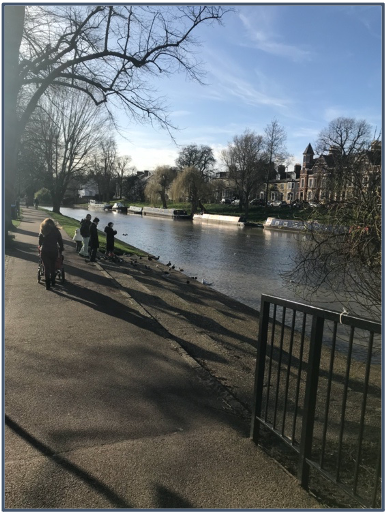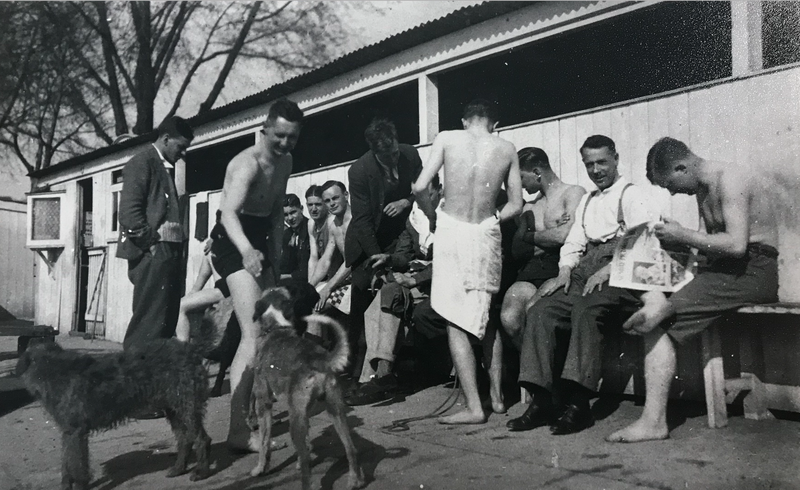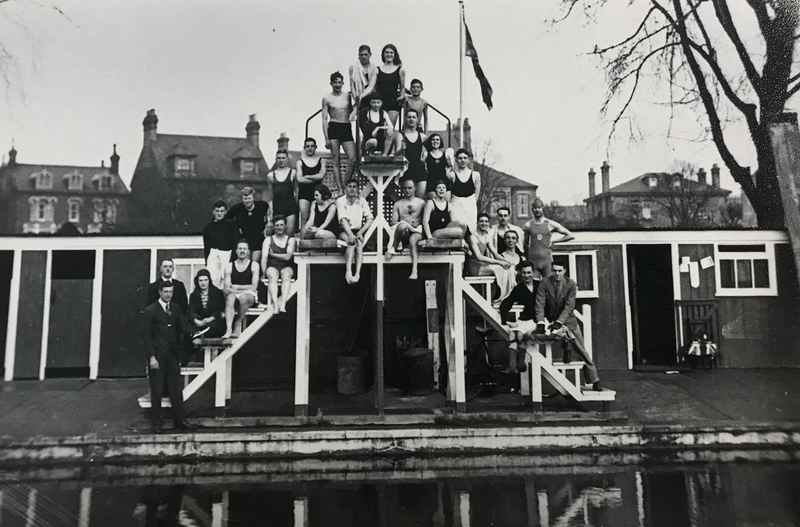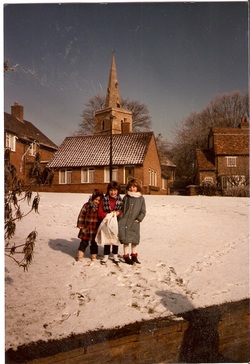|
Jesus Green is a 11.3ha Cambridge City Council owned public park, within the Market Ward of Cambridge and lays to the immediate north of the City Centre. It consists of large open green spaces, a variety and abundance of trees and shrubs, a contained play park, skate park, tennis courts and a large public Lido. The site is situated within what was once a much larger area of historical common land within the River Cam corridor. Victoria Avenue, which bounds the site on its eastern side, separates Jesus Green from Midsummer Common, providing distinction from its previous use as common land to an area of public park. On the north side the site is bound by the River Cam, on the south side the site is bound by a stream called Jesus Ditch which separates the park from the grounds of Jesus College. Park Parade and its small development of early 19th century houses mark out the western boundary of Jesus Green.
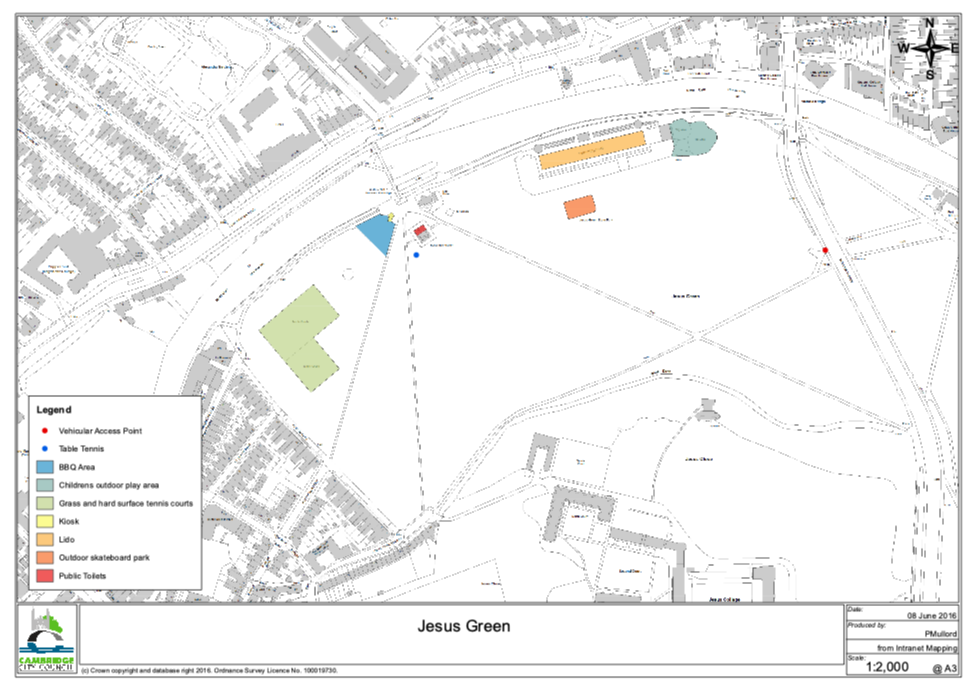
The site of Jesus Green is in close proximity to what is now known as Castle Hill and which, since at least Roman times, has been used to defend the strategic river crossing and associated settlement that is now the city of Cambridge. Whilst Jesus Green is close in proximity to this important site, it has probably remained undeveloped as a result of its low lying, poorly drained nature and the soil type more unsuitable for cultivation.
There is some archaeological merit to the site with records of various items having been excavated or recorded including Palaeo-channels, burials, Plague victim inhumations, Nuremberg tokens and Air Raid Shelter/s. There is the potential for a number of features to be present if excavations were to take place.
Before enclosure took place in the early 19th century, the site formed part of an extended stretch of ancient common land that lay within the flood plain of the River Cam. In 1802 and 1807, the west and east open fields were respectively enclosed. In 1841, the Town Council proposed to enclose the main part of the fields; however, this was prevented due to public opposition.
Regulatory powers over the commons were given to the council in 1884 and were
strengthened in 1922. Later, the land was incorrectly classified as recreational and this has continued. In 1965, when the Commons Registration Act was passed, Jesus Green was not registered as common land. While contested in 1982, this was unsuccessful and as such the land remains classified as recreational and not common land.
Many physical changes have occurred to the site, in particular between 1886 and
1997. A major change occurred when Jesus Green was segregated from Midsummer Common by the building of Victoria Avenue in 1890. This signified a very different approach being taken to the management of the land, with Midsummer Common being retained as informal open grazing land and Jesus Green being developed more formally as a public recreation ground.
Much of the original layout from this period is lost through development that has since occurred, however, the original layout of the paths and avenues on Jesus Green, although changed to an extent, remain largely intact.
The site was made good use of during the First World War with the 6th Division using the site as a camp before deployment.
The 1920’s saw significant development with the construction of an outdoor swimming pool (Lido), putting green, tennis courts, Bowling Green, and a formal space for cricket and football. The character of the site changed from being an open meadow-like space to its current form, as a more formal multi-functional recreational ground.
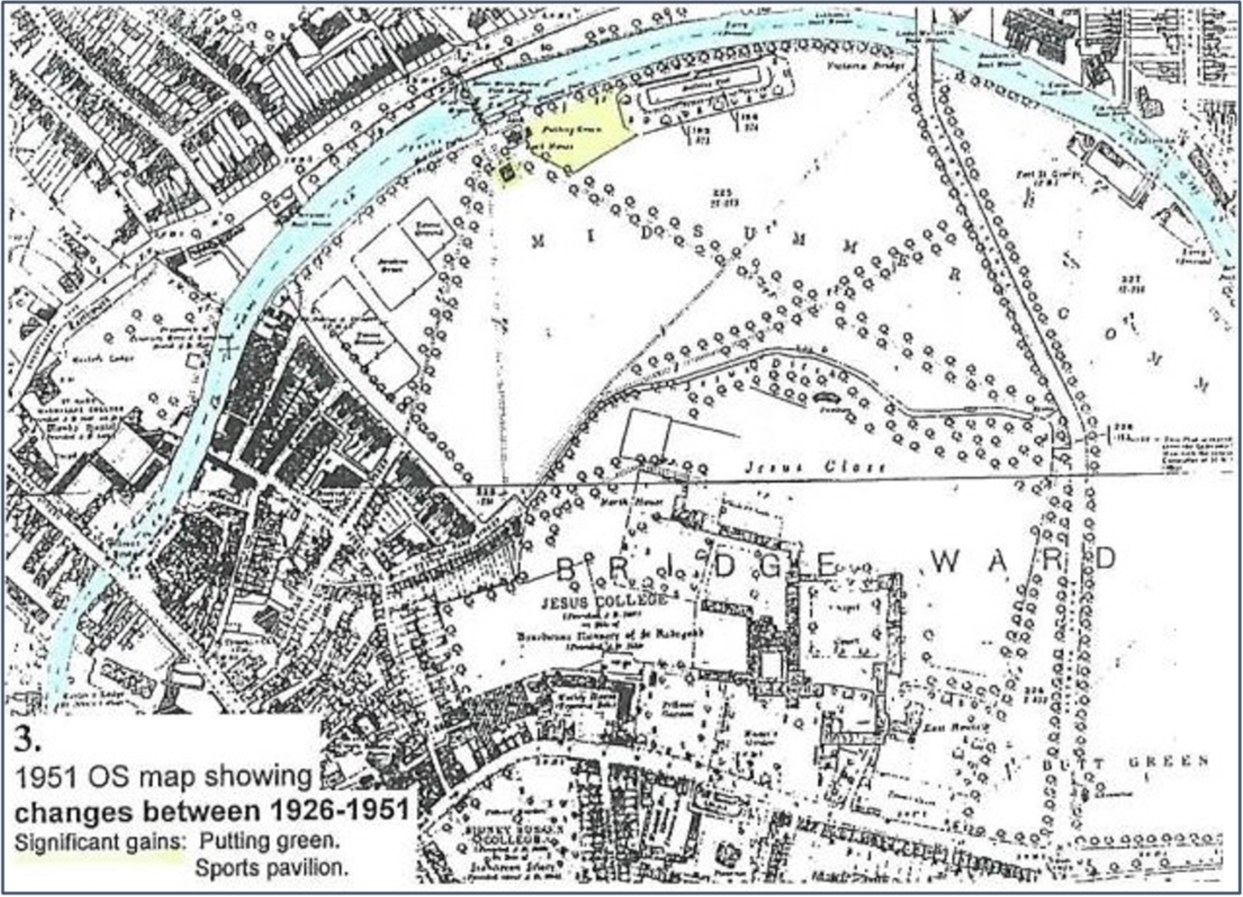 The significant changes to the park are shown by the map above. Courtesy of Cambridge City Council The significant changes to the park are shown by the map above. Courtesy of Cambridge City Council
There was also some increased use on the site for seasonal and annual events. One such event was the annual Horse and Cab show which ran for several years.
The late 19th century and early 20th century saw the layout of avenues, reinforcing
the formal character of the site. There was no record of the presence of trees prior to this date. The most dominant of the avenues runs between Victoria Avenue and the Lock and is lined today by mature London Planes. The nature of one of the avenues has changed over time with the introduction of somewhat smaller flowering species; this is retained to this day.
The 1970’s and 80’s saw further changes to the tree planting scheme with significant planting of limes and beeches.
Built features of the site have also been developed over the years, including, of particular note, the lock keeper’s house that is Grade 2 Listed, the public toilets, and community building, known as Rouse Ball Pavilion (no longer in use).
Later developments have included the construction of a large play area and skateboard park providing modern facilities and increasing the range of activities available, particularly for children and young people. A refreshment kiosk is also provided.
The Jesus Green Lido (opened in 1923), shown in the pictures below, is still in use today and still very popular.
The infrastructure required of a modern park such as bins, benches, and signage completes the transformation to a multi-functional recreation ground with a wide range of features available to the public. Notwithstanding the very significant changes to its original land use, elements of the original Victorian park layout remain. The site has significant historical value. A community project, looking at the social history of the site may identify many important socially historic events.
The park itself continues to provide a much needed, large green space with a variety of parkland features such as the waterway, mature trees, sports areas, play areas and pleasant walks. The site has extensive historical value, from its design as a City Park, through to the way in which it has developed and been affected by some modern development and traffic threats, along with its transition from ancient common land to an extensively used public park.
I will continue to to update this post with more in-depth history of Jesus Green as I go along, I just like to get the basics up so that they are available for anyone who is interested :)
If you'd like to support the work that I do, why not buy me a virtual coffee, I'd be really grateful and it will help keep me going!
Just click on the green button below :)
0 Comments
Michelle Bullivant and sisters out for a walk around Castle Hill area in Cambridge, in the snow around 1984. That day we climbed up Castle Hill and played in the snow - we would often go to this small area of Cambridge and sometimes visit the Cambridge Folk Museum (now Museum of Cambridge).
From left to right - Kerry Bullivant, Michelle Bullivant, Lynsey Bullivant As written by my aunt Val Burroughs ( nee Toller ) March 2005.
Outings During the war we didn't go away for holidays. We used to walk from Oxford Road [Cambridge] to the 'Backs' - the backs of the collages, sometimes pushing our dolls' prams. We would enjoy the crocuses, daisies, lingcups etc. Occasionally when uncles were home on leave we would go as a family. When Uncle George was home, he and Auntie Marie would take us to the Botanical Gardens in Bateman Street. My mother and my granny used to take us to the Folk Museum, one of our favorite places. We would admire the wax dolls in their dolls' prams especially. ( Enid Porter, the curator was a friend of my Auntie Marie [Cruden] in later years though, as far as I know ) We used to climb Castle Hill opposite the Folk Museum. Val Burroughs. Written by Joan Punter (nee Toller) – my aunt – transcribed by Michelle Bullivant Dec 2010
PART ONE: When I was born on 16th April 1940 my father, Eddie, was away in the War. He came home on leave from time to time but I didn’t really have time to get to know him and I apparently got really cross if he and mum danced to the radio together, or kissed and cuddled. We had Russ and Ivy [Russ Broom & his wife – Joan’s uncle, my great uncle] living with us at 100, Oxford Road, so Val [Joan’s sister, my aunt] and I had a lot of attention, games played with them, books read to us and plenty of fun in spite of hours spent under the metal air-raid table, in the cupboard under the stairs (taking turns to sit on the gas meter of all places), and under the piano across the road at No.95. No.95 [Oxford Road] was of great importance in our childhood. Gran, [Ada Broom, formerly Cruden, nee Hatchman, my great grandmother] was there, cooking wonderful old fashioned meals, cakes and pies as did all of her generation. She had also been a kitchen maid, then cook, in service in London as a young woman. It was there she had met her first husband, Cruden. They had George, Arthur and Elsie, then when her husband died of pneumonia in his 30’s, she had to come back to Cambridge where she had support from her mother and sisters, especially Laura and Phoebe. Things were tough and she was very poor. Finally her milkman [Arthur Broom], giving her extra milk and butter for the children, courted her and they married. They had William Hardwick (Bill Broom) in Hardwick Street, then Russell in Russell Street, followed by my mother [my granny] Constance Beatrice. Ada was never one to live a quite life, and she always worked when she could fit it in with her children. I think what caused the most upheaval in the marriage was where she worked at the Globe [pub], Hills Road and started socialising, leaving Arthur minding the children (remember they were not his, and the other three were still very young). There is a true story, told to us by Ada’s sister, Ethel, that one evening when she called at the house, Ada was late coming back from the pub. When she eventually turned up my grandfather said “See, she told me one hour, and it has been three”. With that Ada hit him over the head with a bottle of beer! My grandmother was all heart. She would give her last shilling to a tramp in the street and she loved her children and grandchildren with a deep and protective love; but she had a temper that sometimes frightened people to death. She had had a very hard life and had no time for anyone who was lazy or useless. The stormy marriage ended when our mother [my granny] was 3, so she never had a father figure after that, apart from older brothers of course. The one blessing, I think, that all of my mother’s family had was closeness and support for one another. Ada was always outspoken, even critical, to everyone, though, our mother had to make sure the house was clean when Gran popped over as she might say “What’s that stink in here? You will get the fever!” if something smelly had been left in the kitchen. She had suffered Typhoid Fever and Rheumatic Fever when a young woman so she was very health conscious. Mum remembers, when they lived up Russell Street, if any of them had an accident, Gran would say “Quick, up the “orspidal”, as fast as your legs will carry you!” As Addenbrookes was in Trumpington Street then, it wasn’t far to run. Gran had worked for Turner the magistrate (who officiated at her divorce from ‘Broomy’ as they affectionately labelled him) so on the break up of her marriage Mr. Turner kindly housed them at no.95 Oxford Road “for as long as she lived”! (On her death the house was bought (very reduced in price) by Bill.) So at last, when I was five and starting Richmond Road Infants School, the war ended and my father came home a hero, with his medals and stick with the silver knob on top. We used to play with gas masks on our faces, pretending we were Mickey Mouse, now that they had no use for gas attacks. I don’t want to just record facts and dates in this essay but I would prefer to write a piece with the portrayal of the memories and atmosphere about this time. I sometimes drive down Oxford Road, Windsor and Richmond Roads. I immediately feel the security of the happy years of my childhood. Our house at 110 [Oxford Road] , called ‘Fredaville’, was a usual bay-windowed one, with the ‘front room’ kept tidy and the best furniture in it. We sat there in the sunshine and never messed it up. Our play area was the ‘back room’. It had no bright sunlight streaming in the windows; old chairs, brown worn lino on the floor, and a big old radio by the window in a cupboard. This was our only means of keeping in touch with news, music and comedy and I remember the feeling of dread shown by the grown-ups listening for news on how the war was going. We could be taken over, (with the rest of the world) by the evil dictator, Hitler, our fathers killed , our houses bombed and all of us blown to pieces. However the spirit of our people was always victorious; our father, with his men, would destroy the Nazis forever and we would be safe. Mum was terrified, though, of the planes going over nightly, and the doodlebugs droning over, then exploding. She would drag us shaking, in the stairs cupboard, pitch-black everywhere of course in the black-out, or over to 95 [Oxford Road], making us a fortress under furniture while Gran made cups of tea. You would think Val and I would grow up afraid to leave the house, but it seems to have done us no harm in the long run, for we are both outgoing and confident mothers; so perhaps all our fears were finally put to rest with the jubilation of victory celebrations and seeing our menfolk return, marching proudly and in step along the streets of Cambridge, Union Jacks flying like mad from every house. We seemed to always have a little flag to wave in those happy days. Daddy put away his big kit-bag for good, with his khaki uniform and sergeants badges; Uncle George [Cruden] would no longer be seen in the air force blue uniform, nor Uncle Bill in his firemans one. Everyone was now in ‘civvy street’ and Bill was a grocer again, George was in Mackintosh’s shop in town and our daddy went off every morning on his bike to the Cambridge University Press as a clerk. We now had a baby brother, David, to add to the excitement too, so mummy was always happy and busy, the frequent visits across to Gran’s were now peaceful and jolly, laughter, singing and drinking by the adults at weekends, when Charlie from the Dolamore’s Role on his three-wheeled cycle, puffing and blowing up Castle Hill to bring bottles of booze and lemonade clinking in the enormous metal basket on the front, poor man! We became good friends with Edgar Fletcher, the milkman and his daughter. She always seemed to have interesting pets. He had glass tanks in the garden containing butterflies, I think, also snakes. His daughter told us to come over and see her new baby golden bears. They were actually hamsters, but we had never seen any before, nobody had. Part 2 to follow........ |
Cambridgeshire History Pages:
Contents If you'd like to go straight to a specific article or blog post within the Cambridgeshire History Pages you can click on any of the post titles in the list below and it will take you directly there. Alternatively, you can use the search box above to search by keyword or you can use the index further below. Summerfield: House, Street & Area History, Newnham, Cambridge.
Newnham Walls (Newnham, Cambridge) Church Rate Walk/Newnham Walk/Summerfield. Exciting Old Photograph Album History of Lammas Land, Newnham, Cambridge (Newnham Park) Brief History of Jesus Green, Cambridge Motorbike Girls, Oxford Road, Cambridge c.1928 Violet Broom & Marie Cruden Cambridge University Press Memories by Elizabeth Toller-Brown Teversham Recreation Ground Elton Community Archives Group St Neots Community Archives Group Soham Community Archives Group Cottenham Community Archives Group Stapleford Recreation Ground The Beechwoods Cambridge Guilden Morden Cambridge. Teaching & Artefacts Ely Cambridgeshire Community Archives Group Stilton Cambridgeshire Community Archives & History Cottenham Village Society Haddenham & Aldreth Blossoms & Bygones 1940s Event 2011 Wimpole Folly 1963 St Giles Cemetery, Huntingdon Road, Cambridge - grave of Ada Hatchman (nee Broom) 1955 Oxford Road, Cambridge Violet & Arthur Cruden Passport 1931 Cambridge George Cruden, Military Cambridge c.1940s Oxford Road Cambridge Family c.1935 1st Camb. Headquarters. Cambridge 1925 Rowing on the River Cam 1925 George Cruden, Russell Street, Cambridge The Wayman Family, Oxford Road, Cambridge George Cruden, Oxford Road, Cambridge Marie Cruden, sitting in back garden of house in Oxford Road, Cambridge Eaden Lilley of Cambridge adverts for household items c.1920's Cambridgeshire Transport Section ? WWI Cambridgeshire Transport Section WWI Cambridgeshire Transport Section WWI Arthur Cruden Oxford Road, Cambridge WWII? Room in Oxford Road, Cambridge. 1915-1925 Granny working at Chivers Fruit Farm & Pye Radio Cambridge National School, Russell Street, Cambridge c.1918 Russell Street, Cambridge and Pimple Face! The Globe Pub Cambridge and shoe money c.1915 Great Uncle Russ and the Balloon 1919 Lilly Langtree & Cambridge War Time Child in Cambridge. WWII Cadbury's Picnic Bar, Adkins Corner Heffers Cambridge Picnic by the River Cam, Newnham c.1984 Castle Hill, Cambridge 1984 The Half Moon Inn, Trumpington Street, Cambridge A Garden of Memories by George Cruden Cambridge War Time Letters - Oxford Road Cambridge War Time Letters Home Front Christmas WWII Cambridge Home Front War Letters 1945 WWII Home Front WWII Cambridge Family War Letters More Cambridge Home Front Letters - Vicarage Terrace WWII The War in Cambridge WWII Marie & George Cruden, The Backs of Cambridge Colleges 1941 Outings During the War - WWII Cambridge Memories of Richmond Road School in Cambridge Cambridge - WWII - Toys, Games & Occupations WWII - Food & Clothing - Cambridge Living with the Horrors of War - Cambridge WWII A Child's WWII Home Front Poem - Cambridge Toller Family Tree Notes - all over Cambs Home Front Letters. More WWII Bombing in Cambridge 1941 Home Front Letters WWII Bombing in Cambridge 1941 Tales from Cambridge Part 2 by Joan Punter (nee Toller) Tales from Cambridge Streets during and just after WWII Wall in a Tree, The Botanical Gardens, Cambridge, 2010 National School, Russell Street, Cambridge 2010 Clunch (Chalk) blocks in wall behind Hill's Road 2010 Russell Street & Cambridge Cattle Market voice recording oral history Punting on the River Cam, by Paradise Woods, Newnham. 2001 c.1988 - View from the Top of Great St Mary's Tower, Cambridge 1983 - Arthur Cruden, Cambridge City Bowls Club, Christ's Piece, Cambridge 1983 - Cambridge City Bowls Club, Morley Cup. c.1985 Marie Cruden, Campkin Road c.1975 - George & Marie Cruden Golden Wedding Anniversary, Campkin Road, Cambridge c. 1965 Visitor's Passport for Violet & Arthur Cruden, Oxford Road, Cambridge c.1975 George & Marie Cruden outside St John's Church Cambridge c. 1975 George Cruden, rear view of 146 Campkin Road, Arbury, Cambridge 25th Jan 1941 - George Cruden WWII Views from the building site for the Cambridge Grand Arcade, during the archaeological dig 2005 Archaeology Field Trip in the Fens, Stretham Pumping Engine, 2000. The Birds Nest at Chippenham Park Cambridge 1999 The Old Walled Garden Chippenham Park 1999 Violet Cruden - nee Westley, Histon, Cambridge 1928 Pet Show at the Church of the Good Shepherd, Arbury, Cambridge c.1979 George Cruden, Russell Street, Cambridge c.1918 Arthur Cruden, Bill Goodes & friends, Cambridge. 1910 - 1930 George H Cruden age 17 KRRC Cadets, Cambridge 1917 Elsie Cruden, lived at Russell Street Cambridge About & how to use:This is a blog page for the archives in my own collection. It includes many of my personal & family archives, tales and scrapbook items to all kinds of general archive items from Cambridgeshire UK. The Categories below are really the keyword index of what is on the Cambridgeshire History Pages. Each is a clickable link which will take you to an article or blog which contains that word or subject.
Categories
All
|
